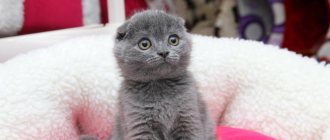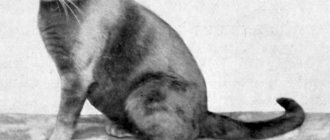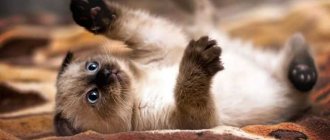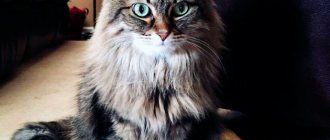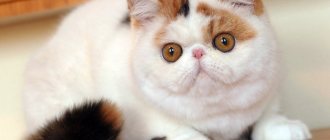Fans of exotic animals can easily fall in love with a safari cat : its external qualities of a semi-wild beauty are wonderfully complemented by the affectionate, friendly character of a domestic cat. The attractiveness of the animal's appearance is genetically determined by the influence of the blood of the wild South American cat Geoffroy. And the affectionate playful disposition is inherited from short-haired cats. The origin of the breed turned out to be a rather complicated matter, but judging by the numerous positive reviews from cat lovers, it was not in vain that felinologists spent a lot of time breeding beautiful cats.
History of the breed
Safari is a hybrid breed that was born in the 70s of the last century thanks to the crossing of a wild and domestic cat. The ancestors of the safari were the South American Geoffroy cat, short-haired Europeans and Americans. The breeders' first experiments were not successful, since the resulting offspring turned out to be infertile. Subsequently, Geoffroy females were crossed with Bengal and Siamese cats.
In the early 80s, the Safari breed was officially recognized and registered. However, some experts still refuse to recognize this breed, arguing that safari representatives are completely no different from the descendants of Geoffroy’s wild cat. But safaris are extremely popular, which is not surprising given their unique appearance, unpretentiousness and good-natured playful disposition.
Character and education
Unlike most semi-wild cats, Safaris are rarely prone to aggression. Even a 15-kilogram kitty will not mind sitting in your arms while watching TV. However, potential owners are advised to sterilize their dogs at an early age, which significantly reduces the chances of dominant or territorial aggression.
Safaris are strong and very active cats. Be prepared for the fact that your ward will turn any object he likes into his toy. To avoid “sabotage”, it is recommended to purchase a variety of toys, from primitive balls to complex interactive mechanisms with buttons and levers. Safaris love to use their sharp claws when climbing trees. In the home, instead of trees, a cat complex or furniture will be used - the choice is up to the owner.
What safaris look like
Safaris are large, beautiful animals. The weight category of an adult representative of the breed can vary from 10 to 12 kg. A distinctive feature of safaris is their special leopard color , like a wild cat, with a predominance of brown, silver or golden shades. Smoky colors also look very impressive, but are extremely rare.
Amazing, hypnotizing eyes - almond-shaped, with the tips of the eyelids slightly raised towards the top. These pets have a long and unusually flexible tail , a large head with pronounced cheekbones.
The animals have a lean, muscular body and long, well-developed legs . The breed belongs to the short-haired category, while safaris are very pleasant to the touch due to the presence of a thick undercoat. It is noteworthy that fur is characterized by the presence of pronounced water-repellent properties.
Safaris are flexible, strong and graceful animals that have inherited natural beauty from their wild ancestors.
Appearance
Representatives of this breed are distinguished by their largest dimensions. The weight of females is about 8 kg, while in males it can reach 13 kg (there are also those that weigh about 16 kg). There are also medium-sized safari cats.
Safari cats are an amazing image of the grace of a predator. Their physique combines muscularity and smooth lines. The breed is characterized by a rounded back and a fairly wide chest. These cats' paws are long and have round pads. The length of the limbs is the same, despite the fact that a creeping gait is usually characteristic of those animals whose hind legs are longer than their front legs. The tail tapers towards the tip.
The head of safari cats resembles a triangle. The chin is small, the jaw is elongated and narrow. The ears, located high and close to each other, are quite large and have rounded tips. Vibrissal pads are pronounced. The shape of the nose is straight and its tip is wide.
Safari eyes are especially beautiful - almond-shaped, widely spaced. The outer corners of the eyes are slightly raised, which makes the look attentive and alert. The eye color is in harmony with the coat color. Safari eyes are green, light brown, yellowish and amber, and the color is uniform and rich.
The coat color of animals of this breed is incredible - it is more complex than that of leopards, although there are significant similarities. The paws and tail are decorated with rings and rosettes, and the body as a whole is decorated with spots and dots. The coat is dense, short, has a thick undercoat, and has water-repellent properties.
About the character of cats
Despite their large size and somewhat predatory appearance, safaris are ideal for the role of pets. Representatives of this breed are very tame, sociable and friendly.
Safaris love to spend time curled up on their laps.
Safaris quickly become attached to their owner and show great devotion towards him. At the same time, these animals cannot be called intrusive; they sense a person’s mood well, know how to occupy themselves and do not require close attention to their person.
Safari cats are very playful, especially when they are young. Therefore, when getting such a pet, you should make sure that he has a sufficient number of toys and a scratching post. The fact is that in the absence of a toy, a pet can use remote controls, phones and other valuables for entertainment, which experienced specialists strongly advise to hide away from them.
The only difficulty that cat owners may encounter is their natural, pronounced hunting instinct. That is why it is not recommended to keep such pets together with other small animals - hamsters, chinchillas, parrots, guinea pigs.
But, if necessary, these animals become excellent mouse and rat catchers. As for other cats and dogs, representatives of the breed get along well with them and find a common language. Safaris become wonderful, loyal friends for children, and take part in their games and fun with great pleasure. They are sociable and sociable, they easily make contact with guests who appear as new people in the house.
Characteristics of safari cats
The great influence of the blood of wild cats has had a certain influence on the breed: do not expect that a pet of this breed will look tenderly at a rodent that is everyone’s favorite of the family. This predator will use all means to get to rats, mice and hamsters, and she will not disdain a guinea pig. But peaceful coexistence with a dog is quite possible.
But the wild ancestor did not have a negative impact on the character of the spotted beauty. Kindness and tenderness are constantly felt in safari cats. These animals enjoy communicating and spending time with their owner. If the latter is busy, then the pet will always find something to do: the top shelves of the cabinets have not yet been examined and the area has not been explored from the height of the curtain baguettes.
Safari kittens have been interested in the flow of water since childhood. Well, it’s no fun to lap up water from a bowl! But if water flows from the tap in the kitchen or splashes in the toilet, it’s worth examining everything carefully, what if drinking the water is even tastier and more enjoyable? Therefore, the best solution would be to install a small drinking fountain in the house.
The safari kitten will be happy to receive the attention of all family members. His gentleness will appeal to both adults and children. The imagination of safari kittens is truly amazing: they can play for a very long time with a candy wrapper, a piece of paper, a forgotten hair band, and with equal pleasure they will take on cat toys bought by a caring owner.
Such a cat will not be very happy about living in a cramped room, but such a predator will be very happy about an enclosure where you can even hunt. If you have the opportunity to go for a walk, then you don’t have to worry about your safari cat getting used to the harness or leash. If you start the process of wearing such things from the moment the safari kittens appear in the house, then no problems will arise.
Advantages and disadvantages of the breed
The undeniable advantages of a safari include:
- playfulness;
- no need for special care or increased attention from the owners;
- sociability and communication skills;
- love of walks and water procedures.
Despite its many advantages, this hybrid breed also has a number of disadvantages:
- pronounced hunting instinct;
- the need to adhere to a certain diet;
- need for increased physical activity.
In general, representatives of the safari breed have many more advantages than disadvantages, which is why they appeal to many cat lovers.
Description
Representatives of the Cornish look sophisticated and gentle, but behind this appearance there is a rather strong animal. Curly hair, strong bones and strong muscles, sharp claws and teeth - this is what distinguishes these cats.
Breed standards:
- The head is egg-shaped or triangular, the muzzle is wedge-shaped, the nose is Roman type, the cheekbones are high and clearly defined.
- The ears are wide at the base, cone-shaped, and set wide apart. The ends are rounded.
- The eyes are slanted, widely spaced.
- The neck is long and graceful.
- The body is strong and agile, the body is slender, the stomach is tucked, and the waist is noticeable.
- The tail is long and mobile.
- The limbs are fine-boned, muscular, and there are long toes on the paws.
- Soft and silky wool is the advantage of the breed. It fits tightly to the body, lies in even waves, and is curly.
- The color can be different, including Siamese (in this case the cat is called a Si-rex).
Nutritional Features
A properly balanced diet is an integral part of keeping cats healthy and fit. Even the best types of food are not suitable for these pets. As carnivorous animals, they need natural food with a higher percentage of meat in the diet.
About 80% of the daily menu should consist of fish and lean meat.
As an addition to the menu, it is allowed to use cottage cheese and fermented milk products. It is not recommended to feed such cats natural milk in its pure form, even in childhood.
In childhood, the number of feedings is up to 5-7 times a day. It is recommended to feed an adult animal 2 times a day, the best option would be morning and evening hours.
What do veterinarians recommend feeding?
In order for the safari to live as long as possible, it is important for the owner to provide her with a healthy diet. It must contain food containing sufficient amounts of vitamins and microelements that are required for this hybrid breed. The emphasis in the diet is on lean meat and sea fish. The menu is supplemented with buckwheat or rice cereals, eggs, and vegetables. Veterinarians from the Zoovet clinic do not recommend giving fermented milk products. However, 2-3 times a month it is permissible to feed the safari with sour milk or low-fat cottage cheese. If we talk about industrial complementary foods that are sold in stores, they should not be given to cats, even when it comes to the most popular foods.
How to care
Safari cats are quite unpretentious in terms of maintenance, but owners of these pets should pay attention to the recommendations of specialists:
- Representatives of the breed love to swim, and water procedures are an integral element of their care. It is recommended to bathe animals with shampoos no more than once every 2 months.
- Shorthaired safaris do not require regular brushing. But during the shedding season that occurs in the fall and spring months, cats need to be brushed every few days to keep their fur shiny, well-groomed and flawless.
- Ear cleaning using specialized disinfectants should be carried out at least once a week.
- It is recommended to wipe your pet's eyes once a week with damp hygienic cotton swabs.
- Claw care is carried out using a scratching post. Once every few months, owners are advised to treat their pet’s claws with a special nail clipper.
The main thing that representatives of this breed need is regular physical activity. Such animals simply love walks in the fresh air, so a country house would be an ideal place for them to live. But even when keeping a safari in an apartment, it is recommended to periodically walk it, at least on a leash. Moreover, they get used to walking uniforms quite quickly and well.
Outdoor games are essential for safari cats. Under no circumstances should you deprive your pet of such pleasure, as otherwise its character and health will deteriorate, the normal functioning of the nervous system will be disrupted, and the risk of developing obesity will increase.
Contents and features of care
Each breed has its own specific maintenance characteristics. It must be said that safaris, despite the exclusivity of the breed, are considered quite simple animals for private breeding.
Nutrition
The main thing in feeding a leopard-colored cat is proper balanced nutrition. The breeder needs to know that even premium cat food is not suitable for safari. The predator must receive natural products daily:
- sea fish;
- lean meat.
You can occasionally give your pet cottage cheese; you should not feed it milk even at a young age. Thus, safaris can be considered quite demanding in terms of nutrition, since you will have to buy good quality food in advance. Meat and fish should make up approximately 70% of a cat's total diet.
Dry cat food is not used for safari. Breeders recommend various types of stews and pates from leading cat food companies:
- Purina ProPlan;
- Brit Premium;
- Royal Canin;
- Hills;
- Belcando.
Purina ProPlan is one of the most common quality cat foods
Due to their large size, safaris require large amounts of food. The amount of wet food is calculated based on the weight of the animal and is usually 5% of the total weight of the cat. That is, if a cat weighs about 5 kg, then he will need approximately 175 g of food per day.
The frequency of feeding depends on the age and status of the animal (for example, young and pregnant cats will need to be fed 3-5 times a day). Typically, feeding is done twice a day: morning and evening.
Necessary living conditions
Safari cats are very energetic and active. Therefore, it will be difficult for them to live in a small city apartment. As mentioned above, the optimal conditions for keeping a safari are in a private home. If the cat lives in an apartment, then it must be walked on a leash, like a dog.
Hygiene and care
Safari cats are excellent at personal hygiene on their own. Therefore, the owner’s main task is to comb out excess hair during shedding . If you plan to bathe a cat, then fur care should not be done using different means for people, since humans and animals have different pH values. Therefore, breeders recommend using hair care products for safari cats from the following manufacturers:
- Vo-Toys;
- "Bioprogress";
- Bio-Groom;
- Biosphere LLC;
- 8 in 1.
All recommendations for care and frequency of use are indicated in the instructions for each product. In addition, safaris love water and will enjoy taking baths. However, it is not necessary to bathe pets more than once every two to three months using special cat shampoos.
Ear cleaning is done once a week. It is enough to wipe the inside of the ear with a damp cotton swab to rid the cat of dirt that she herself could not remove. You can use special ear care products for cats - for example, moisten a cotton tip with Barsik ABZ or Hartz lotion. These products have a natural composition and disinfect the inner surface of the ears.
It is advisable to clean your eyes with folk remedies or natural products. The easiest way to wipe your cat's eyes is with chamomile infusion or strong tea leaves. You can use Cliny C or Sani Pet lotions. The eyes are wiped with a cotton pad soaked in the product as they become dirty - at least once a week.
Due to the fact that safaris roam the streets, they also need nail care. The house must have a scratching post and a nail clipper. The only thing is that if the owner does not have experience in trimming claws, it is better to contact a veterinarian. Some breeders use anti-scratch guards for safari cats, but it is unclear whether this is an acceptable method of grooming for large cats. After all, dirt will accumulate under the caps, which can cause inflammation.
Safari cats are not picky about litter box filler.
About the health of safari cats
Safari cats are distinguished by their endurance, good adaptive abilities, strong immune system, and resistance to most common pathologies. These animals do not have a tendency to develop diseases of a hereditary or genetic nature.
Possible health problems are usually caused by poor diet or lack of physical activity. With proper care and enough attention, cats can live more than 15 years, while maintaining activity, mental alertness and excellent health.
These animals have a well-developed immune system, but with poor nutrition and lack of proper living conditions, they weaken and become vulnerable to any typical cat diseases.
Find out what other breeds of wild cats exist:
- ocelot;
- jaguarundi;
- pampas cat.
Scottish fold
The Scottish Fold cat, or Scottish Fold, is a cute creature with its calling card in the form of lying ears. The distance between the ears of adults is so large that it can accommodate a human palm. It is noteworthy that in kittens, lop ears begin to appear only at 4-5 weeks from birth.
The coat of Scottish Folds can be either moderate or long. It is quite dense and has a uniform structure. Animals have clearly visible “pants” and fur between their toes. Colors can range from rich solids to patterned and tortoiseshell.
Fold-eared cats have amazing calm in any situation - when changing their place of residence, when new family members appear, or during an exhibition. Kittens are very playful, but are afraid of sharp sounds and noise. They are also very stubborn.
Popular articles Test: which dog is right for me
The only care that can be noted is frequent ear cleaning, since more wax accumulates in the ears of Scots.
How to choose the right kitten
Safari is a fairly rare and elite breed of cat. Therefore, the average cost of such a kitten is about $8,000, and an adult representative can exceed $10–12,000. But the point is not only the high cost, but also the problem of finding a nursery to purchase, since there are very few of them, even in the birthplace of the breed.
Of course, at such prices, potential buyers need to be especially careful when choosing their future pet. It is recommended to purchase an animal only from a professional club or from a well-established breeder. In this case, the seller must be ready to provide the baby’s pedigree and passport.
There are often cases when unscrupulous sellers try to pass off representatives of other spotted breeds as safari kittens. But safaris have a number of characteristic distinctive features by which you can recognize the breed even in a small kitten:
- large triangular head;
- straight and long nose;
- uniform eye color, always combined with the color of the cat’s coat;
- almond-shaped eyes;
- specific dark-colored “rings” in the area of the paws and at the tip of the tail.
Safari cats are beautiful, smart, active, playful and very affectionate. This animal will become an excellent friend for the whole family and will not require any special care or close attention. The only thing that safari owners need to take care of is proper nutrition based on natural products, walks in the fresh air, and sufficient physical activity. If these simple conditions are met, the pet will be healthy and live a long, fulfilling life, bringing many joyful moments to its owners.
Interesting Facts
One of the popular cat personalities of our time is a Japanese cat named Snoopy. He is often called a plush cat. He became famous after his owner posted his photos on the Internet.
At first, the owner was surprised when she saw that the posted photos received thousands of likes. But then I got used to it and began to regularly delight Snoopy’s fans with new videos and photographs. The number of admirers is growing every day.
After this, the demand for the exotic breed increased sharply. Breeders did not fail to take advantage of this, as a result of which the price of this breed increased sharply.
The World Wide Web has enormous information potential. Thanks to her, not so long ago, more than seven years ago, all users were amazed by the cutest creature - Snoopy the cat.
It is amazing that this charming pet, owned by a girl from China - Ning, has gained instant recognition among the majority. The “star” of social networks, Snoopy, has captivated many with his unique appearance, incorruptible calmness and, undoubtedly, the trusting gaze of his huge eyes.
exotic shorthair cat snoopy photo
Internet users, intrigued by the animal, frantically began to search for all information related to Snoopy. After all, a significant part assumed that the cat had its origins in Japan. However, this is a misconception.
Snoopy the cat is a separate breed of cat called exotic, or exotic shorthair. But thanks to the Chinese “star” named Snoopy, people call the breed nothing more than a cat of the Snoopy breed.

